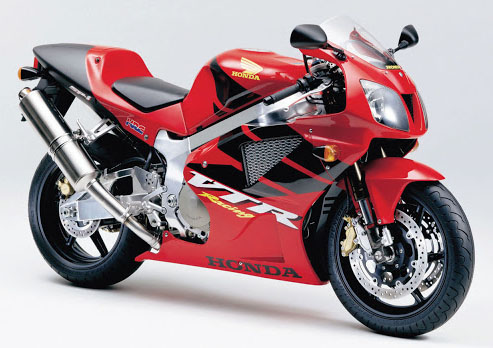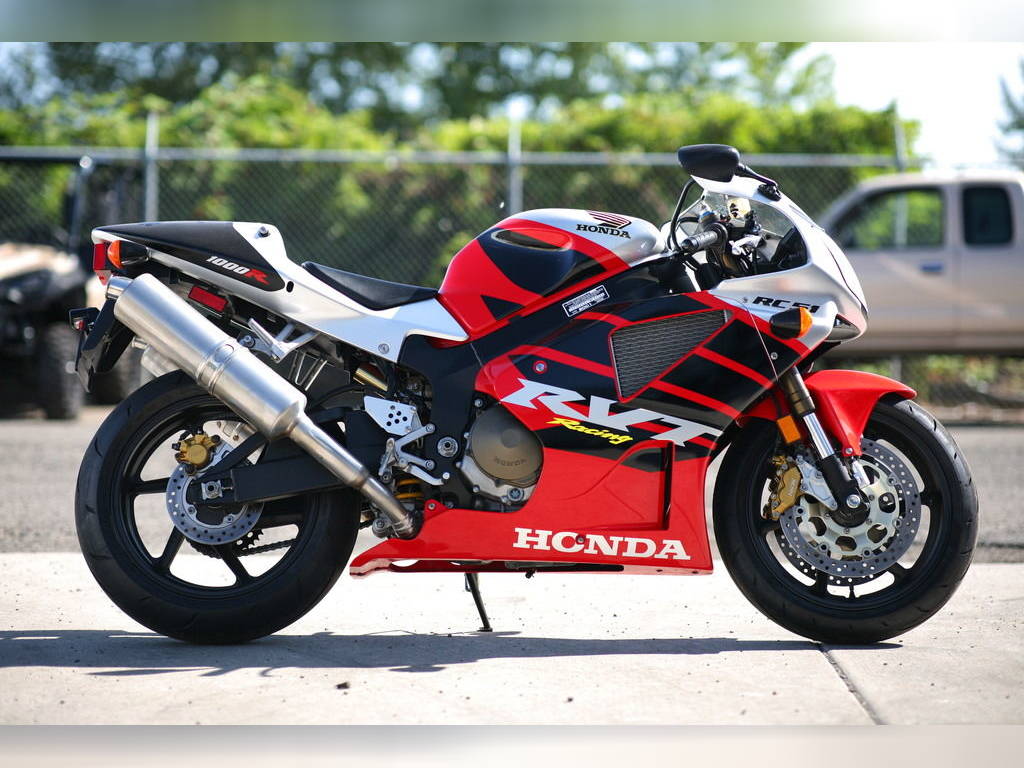Motorcycle Investor mag
Subscribe to our free email news

Future collectible – Honda VTR1000 SP-1 & SP-2
(October 2020)
by Guy ‘Guido’ Allen
Superbike Salvation
Honda was looking for a solution to its Ducati ‘problem’ and the VTR1000 SP series, aka the RC51, was the cure
Here’s a trivia question for you: how many times has Honda won the world superbike championship with a V-twin? I have a suspicion few people, even dedicated motorcycle nuts, could tell you.
To save you looking it up, the answer is twice. Both times (2000 and 2002), it was Texan Colin Edwards in the saddle, with both generations of Honda’s VTR1000SP aka the RC51. That puts Edwards and the VTR in pretty exclusive company – not only as a dual title-holder, but his machine was the only Japanese V-twin to knock off the dominant Ducati at its own game.
You would think, therefore, that either road-going version of the RC51 – the SP-1 or SP-2 – would be highly prized among collectors. However they’re still not quite up there when it comes to market traction.
And that’s a surprise, as this is one of the few pukka race-developed factory bikes out there that doesn’t cost an absolute fortune. Let’s have a squiz at its background.
It’s fair to say that, in the mid to late-1990s, Ducati was comprehensively getting up Honda’s corporate nose. Particularly the good folk over at HRC (Honda Racing Corporation).
If they looked at Grands Prix, their lad Aussie Mick Doohan was hosing the opposition, with a straight run of wins across 1994-98. Then, Alex Criville got the 1999 title for them. There was an unfortunate aberration in 2000, when Kenny Roberts junior took his Suzuki to victory, then order returned for 2001-02 when new boy Valentino Rossi got the laurels back for Honda. All good.
Things were very different over in world superbike. American John Kocinski scored the title in 1997 with his Honda RC45 V-four 750, but either side of that was a disaster. Briton Karl Fogarty won it for Ducati in 1994-95. Aussie Troy Corser did it in 1996, while Fogarty returned and snatched the honours again for 1998-99.
The real bone of contention wasn’t so much the humiliation, but how it was achieved. At that time, V-twins could run 1000cc engines, while multis were restricted to 750 – a rule seen by some as a huge advantage for Ducati.
As the saying goes, if you can’t beat them, join them. V-twin motorcycles were undergoing something of a resurgence in the late 1990s and Honda had launched its VTR1000F – a perfectly civilised and pretty quick road bike. However it was never designed as a racer.
That’s where HRC came in. It took the VTR and re-engineered it for a very different role in life: superbike racing – this was far more than a mere hotted-up road model. It wasn’t just built as a basis for Honda’s own efforts, but as a platform for privateer teams to develop as well.
For a start, the frame was totally different. Where the VTR1000F hung the swingarm off the rear of the powerplant, the SP frame was an entirely fresh and beefier design that braced the swingarm pivot. Speaking of swingarms, the SP version was a work of art and far more robust than its predecessor.
Unique to this model was a steering head specifically designed to provide a straight shot of air through to the airbox. You could, with the air filter out, actually look down the bike’s snout and see the tops of the injection trumpets.
Of course the suspension came in for a major upgrade, with premium Showa gear, as did the brakes. The latter were mounted in a way that made it easy for race teams to experiment with alternative discs and calipers.
As for the engine, the make-over was comprehensive, right down to a completely different lubrication set-up for the crankshaft. Its bore and stroke dimensions were even more heavily oversquare, while the cylinder linings were updated to a coated composite rather than old-fashioned steel.
Fuel injection was fitted, the camshafts were driven by gear (chain-driven on the F), and overall the powerplant featured a number of touches – such as magnesium covers in places – to make it special.
Then there was the bodywork, made through an injection-moulded process that enabled thin and lightweight panels. Really about the only thing this had in common with the road bike was the number of wheels and cylinders.
The result? A shade over 130 horses (100kW) driving a little under 200 kilos. They’re not astounding stats, but were very respectable for the time, particularly for a V-twin. It put it very much in the ballpark of something like a high-end Ducati 996 SPS – a touch more powerful and a little heavier.
Anyone who has ridden one of these things in anything resembling anger will not forget it in a hurry. This was a beautifully sorted motorcycle with a ton of character. Typically for Honda, it was designed to be easy to ride, with a nice flexible power delivery.
Handling was crisp and it was halfway comfortable. Okay, we’re talking in sport bike terms where there’s a fair degree of nose-down bum-up attitude about it. Compared to the equivalent Ducati, though, it was downright luxurious!
And it was fast. The 130 horses was more than enough to make life interesting, while it had sharp steering, quality suspension and decent brakes.
Honda’s gear-driven-cam engines have something special about them and this lived up to that. There’s a very different sound going on underneath you and the overall feel has a bit of an edge to it.
The catch? It was expensive, kind of. In 2000, when a VTR1000F in Australia would set you back around $14,600 (plus ORC), an SP-1 was priced at $21,690. A lot of money.
However a Ducati 996 Strada that year was listed at $25,995 and an SPS at a stratospheric $36,995. In that company, the SP-1 was a bargain, even if it lacked the achingly elegant looks of the Ducati.
Move on to 2002 and Honda has released an SP-2, this time more of an update than a radical departure. The fuel injection is more sophisticated, and the engine is claiming an extra three horses.
Meanwhile the frame is subtly modified with a bigger steering head pivot, longer wheelbase, steeper rake, plus modified engine mounts and swingarm. It has lost a little weight - around five kilos.
From the saddle, the most significant difference is the screen is taller, which mimicked a similar requirement for Edwards’ racer.
I went to the track launch of this model, at Phillip Island, only narrowly avoiding becoming the first person in the world to bin one. That incident said more for the machine’s forgiving nature than my riding skills…
Like its predecessor, it was seriously fast and utterly engaging. It was arguably better from the saddle than the first bike, but really the differences were relatively minor. In any case, Honda had something to celebrate that year: Edwards delivered a second world championship with the platform. The price climbed only marginally, to $21,990 plus ORC.
Owners over time have applied all sorts of tweaks to both generations of these things, including engine power-ups and suspension upgrades. Standard, they were intentionally built with a few inbuilt compromises as Honda saw them being used first and foremost as road bikes – so there was always potential to sharpen them up for the track. Plus, if you were serious about racing, HRC would happily sell you a comprehensive competition kit.
Unlike the exotic V-four RC30 and RC45 predecessors, the RC51s were built in reasonable volume. Exactly how many is a mystery, though the highish sticker prices meant they were still a relatively rare sight on the road.
There is no trouble finding either version for sale, though getting a first-gen that hasn’t been comprehensively messed with can be a challenge. To retain its value, you want something that comes with all the stock parts, particularly the stainless steel exhaust system.
Prices range wildly from around Au$8k all the way up to high teens and maybe nudging 20k for something exceptional. Both versions have potential as collectibles and remain an engaging ride. In a perfect world you’d have an SP-1 and SP-2 in the shed!
Recent prices
SP-1 Graysonline auction Australia, June 2020 – Au$8300 (US$6000, GB£4600)
Fair condition, 45,000km
SP-1 Just Bikes classified Australia, Oct 2020 – $Au11,000 (US$7900, GB£6100)
Modified, Repsol livery, 37,000km
SP-1 Cycletrader classified USA, Oct 2020 – Au$16,600 (US$11,900, GB£9200)
Stock, good condition, 2100ml (pictured above)
SP-2 Bring a Trailer auction USA, June 2020 – Au$10,600 (US$7600, GB£5900)
Good condition, modified, 24,000ml
SP-2 Ebay UK classified, Oct 2020 – Au$8100 (US$5800, GB£4500)
Fair condition, 15,000ml

Colin Edwards
Otherwise known as the Texas Tornado, Colin Edwards developed a reputation for being one of the friendlier and more approachable faces in both the World Superbike and MotoGP paddocks. He was a factory superbike rider from 1995 to 2002, and a GP competitor from 2002 to 2014.
Though he won two superbike titles, his GP career was more difficult and at times held back by questionable machinery.

Honda VTR1000 SP series
Good
Fast
Entertaining
Bad
Stockers not easy to find
SPECS:
Honda VTR1000 SP-1
(SP-2 figures in brackets)
ENGINE:
TYPE: Liquid-cooled, four-valves-per-cylinder, 90-degree V-twin
CAPACITY: 999cc
BORE & STROKE: 100 x 63.6mm
COMPRESSION RATIO: 10.8:1
FUEL SYSTEM: Electronic fuel injection
TRANSMISSION:
TYPE: Six-speed, constant-mesh,
FINAL DRIVE: Chain
CHASSIS & RUNNING GEAR:
FRAME TYPE: Aluminium twin-spar
FRONT SUSPENSION: USD 43mm cartridge fork, full adjustment
REAR SUSPENSION: Fully-adjustable monoshock
FRONT BRAKE: 320mm discs with four-piston caliper
REAR BRAKE: 220mm disc with single-piston caliper
DIMENSIONS & CAPACITIES:
DRY WEIGHT: 199kg
(194kg)
SEAT HEIGHT: 813mm
(820mm)
WHEELBASE: 1409mm (1420mm)
FUEL CAPACITY: 18lt
WHEELS & TYRES:
FRONT: 120/70-17
REAR: 190/50-17
PERFORMANCE:
POWER: 100kW
@ 9500rpm (102kW @ 10,000rpm)
TORQUE: 105Nm @ 8000rpm
OTHER STUFF:
PRICE NEW: Au$19,690 plus ORC ($19,990)
-------------------------------------------------
Produced by AllMoto abn 61 400 694 722
Privacy: we do not collect cookies or any other data.

Archives
Contact




